Cultural Cocktail Hour
Review: By Day and by Night: Paris in the Belle Époque- A MUST SEE Exhibit at the Norton Simon
Review
The darkness and light of LA Belle Époque at the Norton Simon Museum
October 4, 2019-March 2, 2020
by
Leticia Marie Sanchez
La Belle Époque, which means the “beautiful age,” evokes thoughts of frothy, light-hearted spectacle: can can dancers, entertainment posters, cabarets, bistros, and electrifying nights at the theater during France’s Gilded Age. However, the Norton Simon Museum’s exhibit By Day & by Night: Paris in the Belle Époque reveals the deeper psychological dimensions beneath the glittering surface: the dichotomy between dynamic crowds and a sense of isolation, between affluent patrons and an often despairing working class, and between a frenzied pace and moments of pause. This vast exhibit includes works by Henri de Toulouse-Lautrec, Édouard Vuillard, Pierre Bonnard, Edgar Degas, and Pablo Picasso.
The exhibit was expertly curated by Norton Simon Acting Chief Curator Emily Talbot whose curation revealed a nuanced and profound portrait of La Belle Époque while also depicting the stylistic developments of the period. Talbot organized the exhibit into three compelling suites: the street scenes of Pierre Bonnard which alternated between the melancholy and the dynamic, the entertainment culture of Henri de Toulouse-Lautrec, and Édouard Vuillard’s serene domestic interiors.
Here are a few highlights of this MUST-SEE exhibit:
2. Pierre Bonnard’s House in the Courtyard
In this work, Bonnard aligned the window with the margins of paper, creating a sense of loneliness and voyeurism. The window evokes isolation, reminding us that that not everyone partook of the festivities of La Belle Époque.
Pierre Bonnard (French, 1867-1947)
House in the Courtyard from the portfolio Some Aspects of Life in Paris, 1895-96, published in 1899. Lithograph. 21 X 16 in. Norton Simon Art Foundation
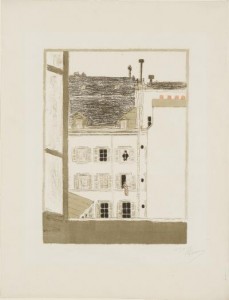
2. Henri de Toulouse-Lautrec At the Cirque, Fernando, Rider on a White Horse
In this piece, I was struck by how Toulouse-Lautrec conveyed the velocity and motion of a circus rider. The focal point, the three-dimensional female rider, is captured in a vortex of pause, while the world swirls around her, the horse’s galloping speed evoked by the intense effect of Toulouse-Lautrec’s brushstrokes. Even more astounding is the fact that Toulouse- Lautrec painted this incredible work on cardboard!
Henri de Toulouse-Lautrec (French, 1864-1901), At the Cirque, Fernando, Rider on a White Horse, 1887-1888, Pastel and drained oil on board; 23 5/8 X 31 1/4 in. Norton Simon Art Foundation
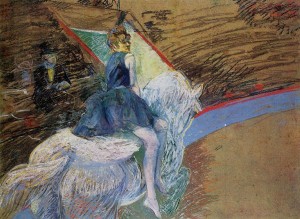
3. The Moulin Rouge by Pablo Picasso
Pablo Picasso’s The Moulin Rouge is a rarely seen work with a mysterious figure in a whimsical hat. She boldly looks out at the viewer. Who is she? A courtesan? A prostitute? Is a mirror separating her from the other couple? Is she literally and figuratively divided from the fashionably dressed couple due to her potential role of moral impropriety? Picasso’s work embodies the playful spirit of the age. It illustrates fact that a disparate group of insiders and outsiders comprised the complex society of the Belle Époque era.“The Moulin Rouge” Pablo Picasso (Spanish, 1881-1973) 1901, China ink on paper, 12 3/4 X 19 1/2 in. Norton Simon Art Foundation

4. Edgar Degas’ Women Ironing
Not everyone during La Belle Époque was indulging in cafe society or evenings at the opera. The painting depicts the suffocating plight of female laundresses whose employers plied with bottles of wine in an attempt to make them endure their 12-hour shifts. The exhausted female figure on the left has a look of despair, her facial expression calling to mind the desperation in Edvard Munch’s The Scream. Stylistically, these figures have moved away from representational art, in the sense that painting during this era used to evoke rather than to depict. For instance, Degas skillfully rendered the image of steam to give us a sense for the daily life of the laundresses. Edgar Degas (French, 1834-1917) Women Ironing, c. 1875-76; reworked c. 1882-86 Oil on canvas; 32 1/4 X 29 3/4 in. Norton Simon Art Foundati
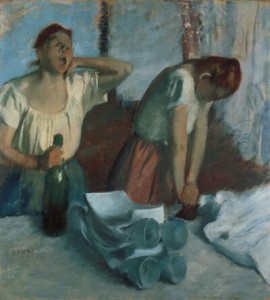
5. Louis Anquetin’s Portrait of a Woman Versus Henri de Toulouse-Lautrec’s The Streetwalker Comparing and contrasting two disparate renditions of prostitutes underscores the humanity with which Toulouse- Lautrec imbued his work. The works by Anquetin and Toulouse-Lautrec are displayed side by side in the exhibit, allowing one to see the immense differences in the two depictions, one rendered coarsely and the other sensitively.
Louis Anquetin renders the prostitute as nothing more than a caricature. She leers at the viewer, her body offered in a vulgar fashion. Her face is depicted as graceless, and her intrinsic worth is reduced to her impossibly gargantuan breasts. Louis Anquetin (French, 1861-1932) Portait of a Woman, 1891 Pastel on Paper 24 3/4 X 20 in. Norton Simon Art Foundation
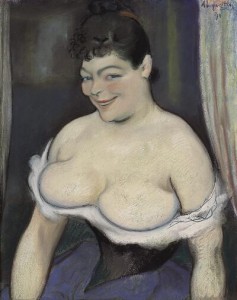
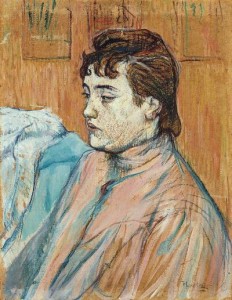
On the other hand, Toulouse-Lautrec’s The Streetwalker is a compassionate portrait of a woman in a brothel. Despite having been born an aristocrat, Toulouse-Lautrec showed great empathy for those living at the margins of society. Perhaps his own physical impairment caused him to view those those often thought of as outcasts with compassion. This portrait of a prostitute is intimate; Toulouse-Lautrec depicts her in a moment of pause. This reflective moment is Toulouse-Lautrec’s way of telling his viewer that his subject is someone worth our gaze. Henri de Toulouse-Lautrec (French, 1864-1901) The Streetwalker, 1892-1894 Oil on cardboard. 29 3/4 X 19 1/8 in. Norton Simon Art Foundation
Every time I step into an exhibition at the Norton Simon Museum, I am astonished by the collecting foresight of Norton Simon, who amassed a treasure trove. With the exception of six loans from LACMA, the abundant works filling the three galleries of By Day & by Night: Paris in the Belle Époque– from Pablo Picasso’s bronze Head of a Jester to George-Pierre Seurat’s Stone Breakers to Edgar Degas’ Women Ironing– the paintings, drawings, prints, lithographs, and photographs all pertained to the massive collection of Norton Simon. Thanks to his collecting tenacity, I was able to travel back in time to the Belle Époque delving into the lightness and darkness of the era.













